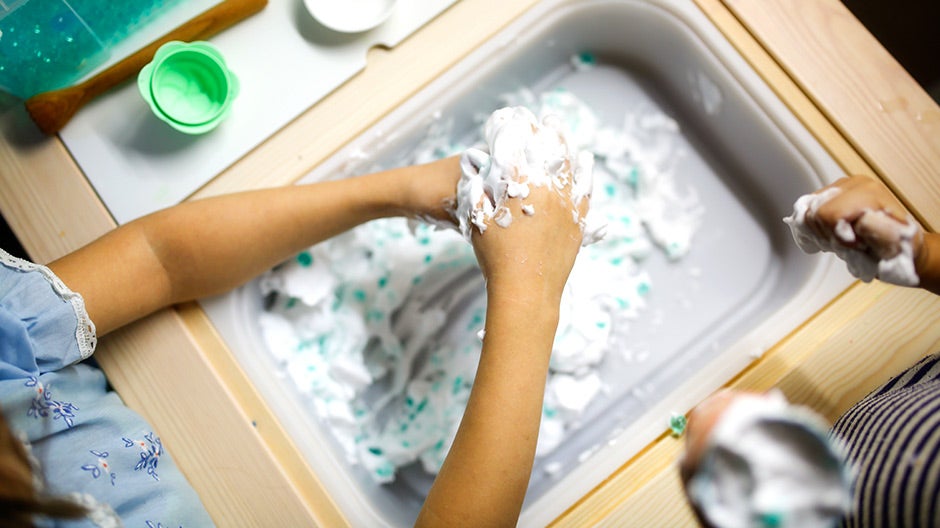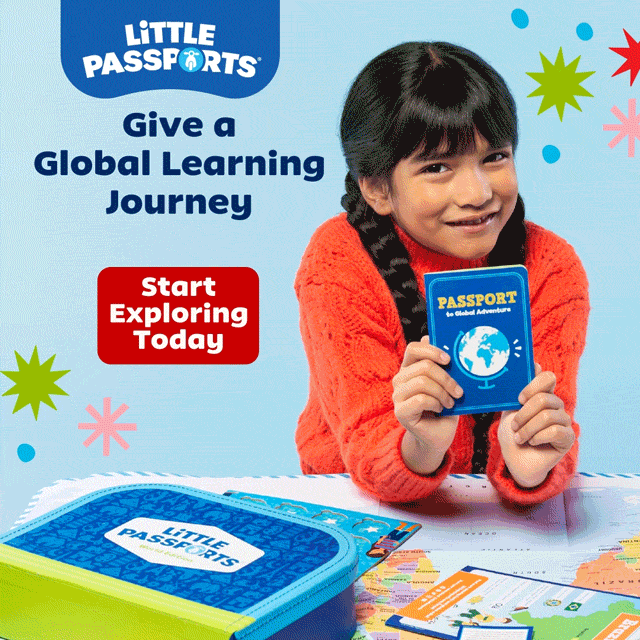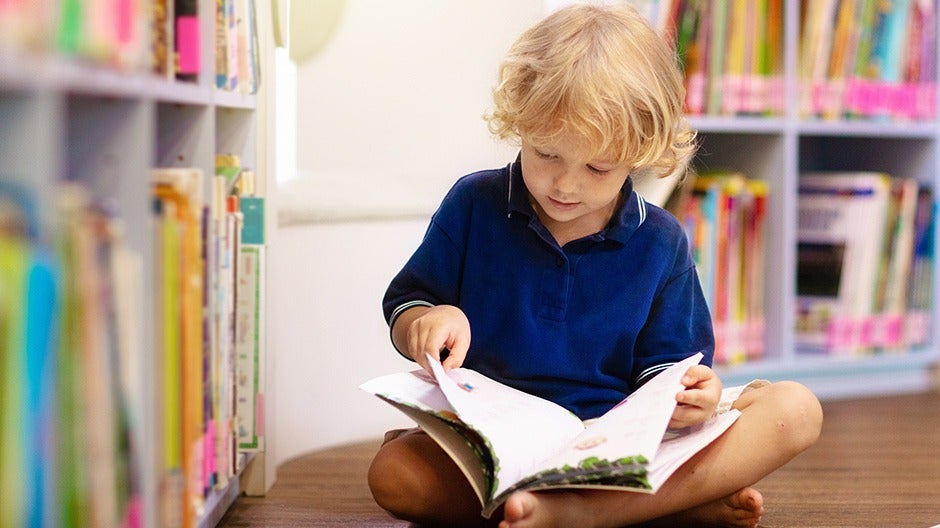Ooey, gooey, sticky, squishy, smooth, fun stuff! Whether you’re mixing up colorful bags of shaving cream, playing a sensory treasure hunt game, or bulldozing beans and flour, sensory activities for toddlers are a great way to introduce kids to the wonderful world of texture.
Looking for a place to start? We’ve put together this list of 12 great toddler sensory activities you can do at home.
Table Of Contents
- The Short Cut
- What Is Sensory Play?
- Why Are Sensory Activities for Toddlers So Important?
- 12 Sensory Activities for Toddlers
The Short Cut
- Sensory activities help toddlers maintain their Curiosity, one of the 5 C’s at the heart of the Begin Approach to helping kids thrive in school and life.
- Sensory play also engages kids’ senses and encourages them to move their bodies, a Core Skill that helps their brains develop.
- Many sensory activities for toddlers can be created with things from the home—it’s easy and fun!
- Developing the 5 C’s doesn’t need to be complicated. You can make a big difference in only 15 minutes a day!
What Is Sensory Play?
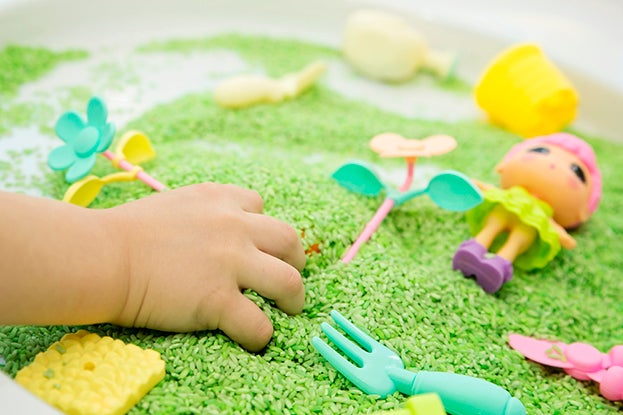
Sensory play is any activity that engages one or more of a child’s five senses: sight, hearing, touch, taste, and smell.
Experts also consider sensory play to be any activity that helps kids develop their balance (specifically the vestibular system that helps them know what their heads are doing) and sense of where their bodies are (called proprioception).
Why Are Sensory Activities for Toddlers Important?
Whether through DIY activities or everyday playtime, there are many benefits of sensory play for toddlers. Let’s take a look.
Helps Make New Connections
Using their senses helps toddlers’ brains make new connections, literally shaping how their minds engage with the world. These new nerve connections will come in handy as they are asked to do more difficult tasks.
Develops Fine Motor Skills
Kneading dough, using kitchen utensils, trying to grab a wet piece of pasta—all of these things utilize your toddler’s fine motor skills.
The more your little one engages those small muscles in their hands and fingers, the more their brain and nervous system practice controlling the movements.
Builds Your Toddler’s Vocabulary
As you describe what your child is touching, hearing, smelling, seeing, or tasting, it helps build important vocabulary. This enhances their ability to describe colors, shapes, scents, and tastes.
Allows for Social Interaction
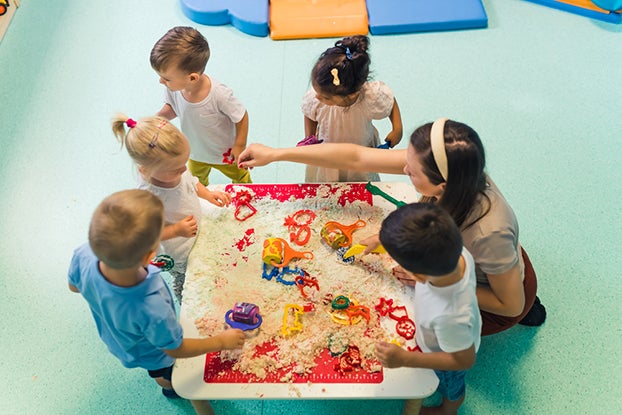
Fun sensory activities for toddlers also offer chances for social interaction, which helps them build Character, another of the 5 C’s.
Develops Critical Thinking Skills
Many sensory activities (like searching through beans for a toy) involve problem-solving, helping to develop Critical Thinking.
Develops Creativity
Of course, because sensory activities are free-form in nature, your toddler is able to use their imagination while they are learning. They can pretend they’re a top chef or a mad scientist, create a sculpture, or work up a creative storyline as they play.
12 Sensory Activities for Toddlers
We’ve put together a few of our favorite sensory activities for your little one for some hands-on learning.
1) Sensory Ocean Zen Garden
This zen garden is a great way to give your child something fun to do outdoors on a nice afternoon—and like many sensory activities, it can help an overstimulated toddler calm down!
What You’ll Need
- Bag of stale cereal
- Baking pan or play bin
- Shells, stones, and ocean animal toys
- A fork
What to Do
- Use a blender to grind stale cereal pieces up to make the “sand” base
- Pour the “sand” into your pan or bin, then spread it out until it forms a smooth surface
- Add shells, pebbles, and ocean animal toys
- Give your child a fork or a shell and demonstrate how to make strokes and patterns in the sand. It might calm your senses down too!
2) Ocean Sensory Bin
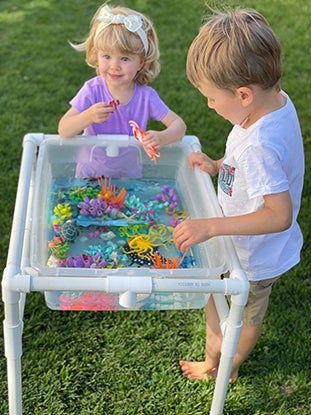
Take dried pasta, then add ocean toys and water, and you can create a fun sensory bin for toddlers to explore!
What You’ll Need
- Medium-sized bin or deep tray
- Dried pastas for coral
- Child-safe, non-toxic paint
- Playdough
- Water
- Blue food coloring (optional)
- Scoops or cups for playing in the water
- Ocean creature toys
What to Do
- Put one cup of dried pasta into a resealable plastic bag or container, then squirt paint in until the pasta is covered. The pasta will represent coral, so use vibrant colors like pink, purple, and green.
- Seal the container or plastic bag, then shake it up so the pasta becomes covered in paint. Take the painted pasta out and lay it on a baking tray to dry.
- Shape the play dough into small “rocks,” then add it to the bin. Press the pasta into the play dough and presto! Your “coral” is complete.
- Now that you’ve made your reef, it’s time to put it under the sea! Add water to the bin until the coral is partly covered (leaving some exposed creates more play surfaces). You can add blue food coloring to make it look a little more like the ocean if you want.
- Set your water and ocean animal toys out next to the bin for the kids to play with. Now they’re ready to explore the ocean world!
Play Tips: You can use this activity to encourage problem-solving. Many times something your child wants to do, like placing a turtle on the reef, won’t work the first time. Encourage them to try different approaches until they find one that works.
This mimics the scientific method of observing, forming a hypothesis, experimenting, and drawing conclusions.
3) Color Mixing Sensory Bag
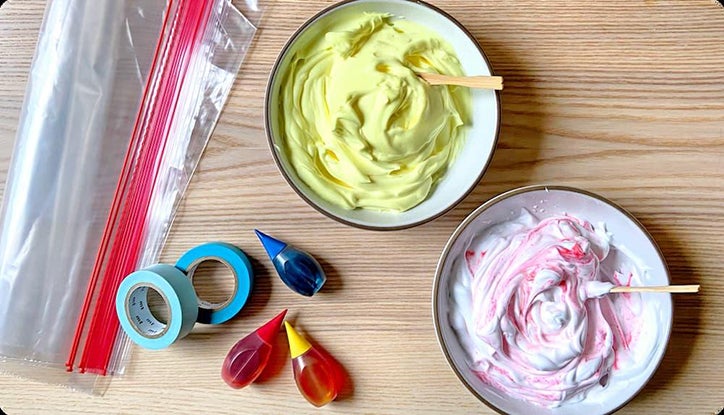
What do you get when you mix two colors? A third color! Exploring how this works invites your child to name colors and discover how they relate to each other.
What You’ll Need
Icing or shaving cream
Food coloring
Two small bowls
Toothpick or spatula
Large zip-top bag and tape or cookie sheet (the cookie sheet option lets kids get their hands on the activity a little more, but the bag creates less mess)
What to Do
- Put about a cup of shaving cream or icing into two small bowls.
- Pick two colors of food coloring to mix.
- Add a drop or two of color into each bowl, keeping the colors separate.
- Let your child mix the colors into the shaving cream or icing with their hands, the toothpick, or the spatula until they’re well blended.
- Tape the bag to a working surface or lay out the cookie sheet.
- Close the bag, then let your child mix the colors by squishing and smushing the bag until the colors are blended.
- Scoop some of each color into the bag or onto the cookie sheet, then let your child smush them together until they make a new color.
Play Tips
- Encourage your child to experiment with the different tools you got out. The toothpick has very different results than the spatula!
- If you use food coloring and icing, you can make this part of an afternoon of baking by spooning the colored icing onto cookies when you’re done!
4) 2 Ingredient “Sandy” Sensory Bin
A little flour and oil can bring beach exploration home for your toddler!
What You’ll Need
- 6 cups flour
- 1 cup oil (vegetable, canola, or baby oil work well)
- Ocean objects of your choosing! Try pasta shells, plastic fish and sea creatures, or textured rocks
- Plastic bin or cardboard box
- Old toothbrush (optional)
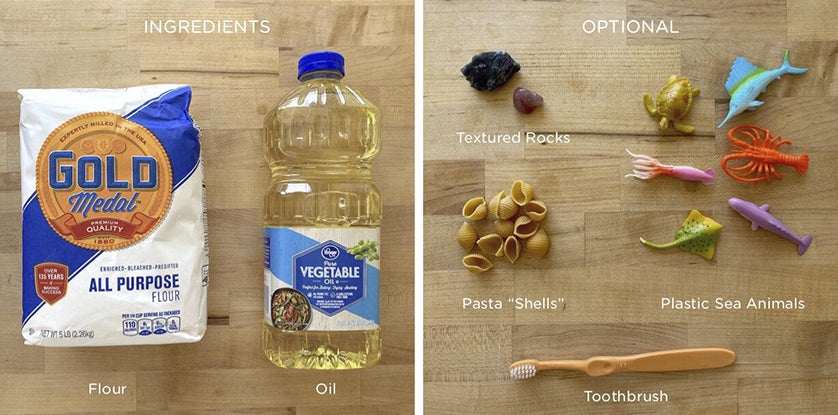
What to Do
- Mix 6 cups of flour and 1 cup of oil in a bowl to create the sand. Using a fork, press the oil into the flour and mix until the texture becomes sandy. Some toddlers enjoy helping with this step, or you can do it yourself ahead of time.
- Transfer the sand into the bin or box.
- Press objects into the sand to bury them (or pour sand over the top), then encourage your child to sift through the sand to find them and see how it feels as they search!
NOTE: This activity can get messy, so play it outside or on an easy-to-clean surface.
Play Tips
- After you’ve hidden your objects, encourage your child to describe them as they find them and group them into categories (all the green ones, all the animals, etc.)
- Pretend you’re at the beach! Wear bathing suits, spread out a towel or blanket, and get out your favorite beach toys like toddler-sized shovels and rakes.
- Make it a good-natured race! Hide the items, then invite a sibling, friend, or grown-up to play along. Who can find them the fastest?
5) Dump Truck Sensory Bin Activity
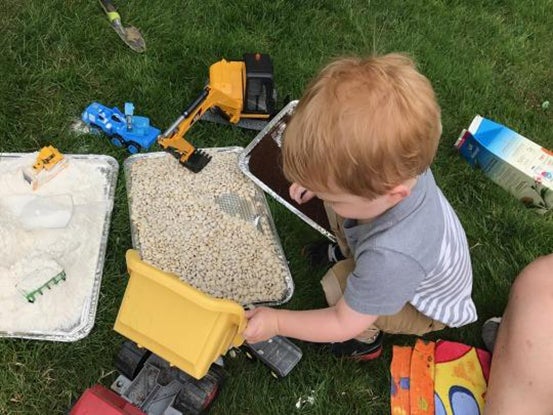
Samantha Creighan, Begin’s Vice President of Curriculum Design, created this activity for us several years ago, when her son was two years old and obsessed with construction vehicles. It took advantage of his natural interest in vehicles (a great way to encourage Curiosity!), and it perfectly pairs with the “Dump Truck” story in our HOMER app!
What You’ll Need
- 3 disposable cookie sheets
- Flour
- Decaffeinated coffee grounds
- Dried beans
- Construction toys
- Shovels, cups, or small buckets
- Spray bottle filled with water (optional)
- Sifter (optional)
- Rocks, leaves, and sticks (optional)
What to Do
- Set the cookie sheets outside or in a play area that’s easy to clean.
- Fill one cookie sheet each with flour, decaffeinated coffee grounds, and dried beans.
- Lay out the construction toys, shovels and cups, and spray bottle near the trays so they’re ready to play with.
- Invite your child to play construction site! The toys can push the materials around, roll through them, get stuck and unstuck, and more. And the shovels and cups can help make mounds to dig through or roll up.
Play Tips
- To extend play, use the sifter to get the different materials wet, and see if your child can figure out how to use the resulting changes in their construction projects
- Add rocks, sticks, and leaves to the trays and encourage your child to see how they affect the vehicles and how they can be used (to make trees, structures, etc.)
- Try the same activity with other kinds of toys—your child could make a dinosaur world, a fairy tale wonderland, a zoo, or anything else they’re excited about!
6) Scoop the Goop Sensory Play
This is a popular option when it comes to sensory activities for toddlers, as it’s simple and requires things that are probably already in your kitchen.
What You’ll Need
- Cornstarch
- Water
- Colorful food coloring
- Bowls
- Various spoons, spatula, whisk, hand mixer
The above-listed kitchen supplies are only examples. Feel free to use what you have. The goal is to allow your child to stir, scoop, mix, and pour the colorful concoction and see how the consistency changes as they do.
Keep in mind, it might get a bit messy, but that’s half the fun!
What to Do
- Set your play space in an area that’s easy to clean up, like a kitchen or play table that’s been set with a disposable tablecloth.
- Pour cornstarch into the bowl and add water until you reach your desired consistency. Then add a few drops of food coloring. You can choose a color that matches the season, like orange for Halloween or red for Valentine’s Day.
- Ask your toddler to try the various kitchen utensils to scoop, mix, blend, and pour the colorful concoction. Remember, sensory play doesn’t have specific rules—it’s all about experimentation.
- Get your toddler talking about what they notice as they play with the goop.
- At the end of the fun, it’s time for clean up. Involve your little one in that as well, as it’s all part of the sensory experience.
7) I-Spy Bottle
An I-Spy bottle is easy entertainment, giving your little one loads of search-and-find fun.
What You’ll Need
- Plastic water bottle
- Rice
- Hot glue
- Alphabet or number beads, small found objects, LEGOs, or other “treasures” to spy
- Funnel (or paper and tape for a homemade version)
What to Do
- Gather your supplies.
- Roll a piece of paper into a funnel (or if you have a funnel, use that) and pour rice into the bottle through the funnel until it’s about a quarter full.
- Add surprises like alphabet beads, LEGOs, or other found objects from your home. If it’s an evening activity, see if you can find items that glow in the dark!
- Shake the bottle well.
- Add more rice and surprises until the bottle is nearly full. You’ll want to leave a little room, however, so that items can move around when you shake the bottle.
- Seal the top of the bottle with hot glue.
- Give the bottle a final shake.
- Ask your child to tell you what they spy as they shake and reshake the bottle.
8) Pirate’s Bounty
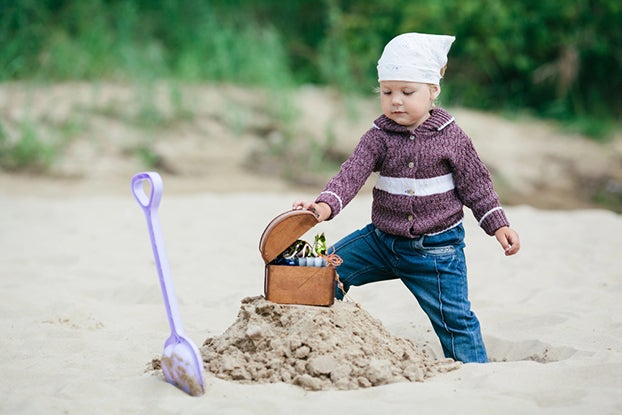
With Pirate’s Bounty, your toddler will don their pirate costume and go on a search for treasure. They can sift through the sand and find coins, gems, and other such loot.
What You’ll Need
- Empty baby wipe container
- Large bin that the baby wipe container can fit into
- Kinetic sand
- Gold spray paint
- Craft jewels
- Coins
- Beach shovels or rakes
- Magnetic letters and numbers
- Pirate costume
What to Do
- First, paint the baby wipes container with your gold spray paint. You’ll want to remove the lid so that the paint covers the inside and outside of the container. Let it fully dry.
- Fill the larger container with Kinetic sand. If you don’t have pre-made sand, you can DIY some yourself.
- Hide craft jewels, coins, and magnetic letters and numbers in the sand.
- Add a little pretend play to the experience, and invite your child to put on an eye patch and a pirate’s hat to get in the spirit.
- Now it’s time to search for the loot using the beach rakes and shovels. Have your toddler place any bounty they find in their gold “treasure chest.”
9) Pasta Play
Here’s another sensory activity for toddlers that’s sure to delight. The slippery noodles are hard to catch, but it’s fun to try as they test their fine motor skills.
What You’ll Need
- Large bowl
- Pasta pot
- Dry pasta
- Water
What to Do
- Boil the water and cook the pasta. This time you don’t have to make sure it’s al dente!
- Strain the pasta and let it fully cool down.
- Ask your child to wash their hands.
- Put the pasta in a large bowl and invite your child to play with their food.
Play Tips
- Mix up different types of pasta to enhance the experience. Playing with penne is different from spaghetti. You might even try some tri-color pasta to add opportunities for sorting.
- Add on more foodie adventures, as the kitchen offers countless opportunities for sensory fun. For instance, Begin’s Kitchen Adventures kits provide monthly recipes and activities to try. The first kit is set in Rome, Italy where your toddler can learn food history, play games, and cook our curated recipes from each stop on their culinary journey.
10) Name The Smell
Mint or cinnamon? Lavender or rose? Making scent jars will help hone your little one’s sense of smell.
What You’ll Need
- 5 small containers with soft plastic lids
- Pin (to make holes in the lids)
- Lemon zest, cinnamon stick, coffee beans, mint, lavender, or other odiferous ingredients (alternatively, use cotton balls and essential oils)
- Blue painter’s tape if your containers are clear
What to Do
- Using the pin, stick holes through the lids of the small containers.
- Fill each container with a different scented element. If you are using essential oils, place a few drops on a cotton ball and put the cotton ball in the container.
- If your containers are clear and you’re using foods and herbs in your scent jars, cover the sides of the jar with blue painter’s tape so that your child can’t peek. The activity is to guess what’s in the jar using scent, not sight.
- Have your toddler smell each container one by one and ask them what they think the scent may be and where they’ve smelled it before.
11) Be the Jeweler
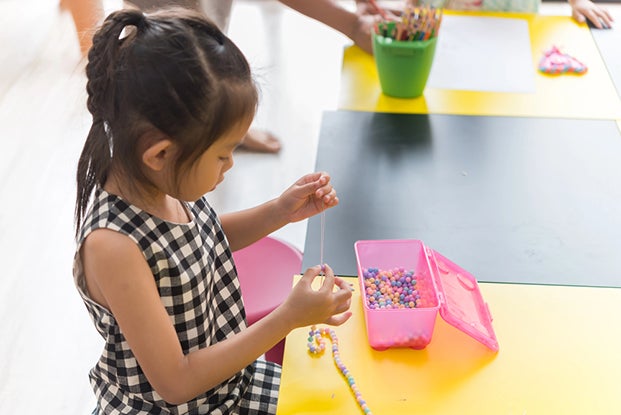
Fill a bin with beads and colorful pasta along with some string or yarn and have your little one get to work on an amazing accessory.
What You’ll Need
- Plastic bin
- Sorting cups
- Colored penne pasta
- Foam beads
- String or yarn
- Tape
- Scissors
What to Do
- Set out your materials. Place all beads and pasta in the plastic bin.
- Cut string for necklaces and bracelets.
- If they prefer, give them cups to sort the different beads and pastas, so it’s simple for them to create their pattern.
- Tape the end of the string to the floor or table so that beading is easier.
- Encourage your little one to string the pasta and beads in their chosen design.
- When they’re done, tie off the string and let them wear their special creation.
If your child loves the tactile stimulation of crafting, Begin’s Craft Discovery kits provide even more opportunities for hands-on creative fun. Your toddler can build a bird feeder, decorate eggs, or make mini pinatas.
We also offer a Summer Playcation pack with six hands-on activity kits that stimulate your child’s senses while getting them outdoors.
12) Listening Walk

Speaking of outdoors, another of our favorite sensory activities for toddlers involves practicing the sense of hearing by taking your toddler on a listening walk.
A listening walk invites your child to focus on the sounds they hear as they go—the bark of a dog, rustling leaves, or a fire engine driving by.
What You’ll Need
The beauty of this activity is that you don’t need anything but a comfy pair of shoes and a coat if it’s cold!
What to Do
- Choose a route for your listening walk. You can walk in the woods or around the block. There will be different sounds depending on where you go.
- Decide how much time you’ll spend. Ten to fifteen minutes is a good amount of time, as it’s long enough for a variety of sounds, but not so long to lose focus.
- Ask your child questions as you walk. What do they hear? Where do they think the sound is coming from? How do they know?
More Toddler Play with Begin
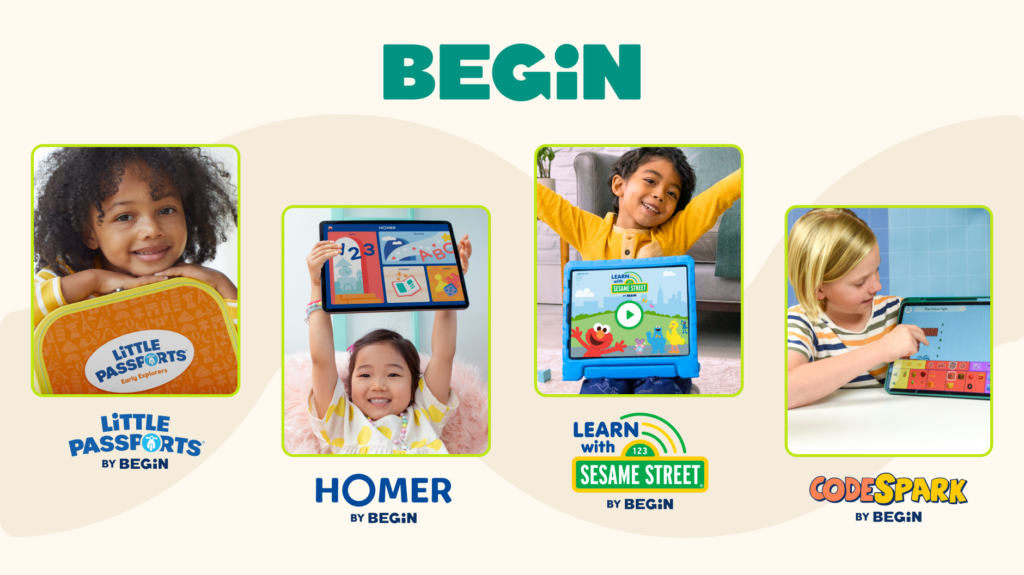
We love sensory activities for toddlers because they’re so good for them in so many ways—encouraging Curiosity, building Critical Thinking skills, helping develop Character, and more. Plus they reach kids through the power of play, the most natural way for them to learn.
Play can help toddlers in other ways too, from pre-reading and math skills to learning to name emotions, share, and practice kindness.
Our age- and stage-matched learning membership helps kids (including toddlers!) develop the skills they need most, all through fun, age-appropriate hands-on and digital play. Take our online quiz and see how we can help your family today!
